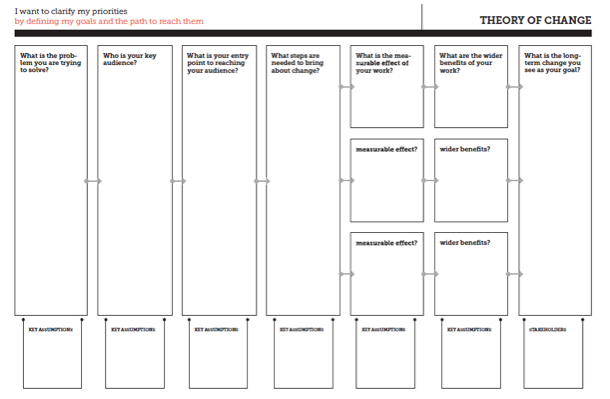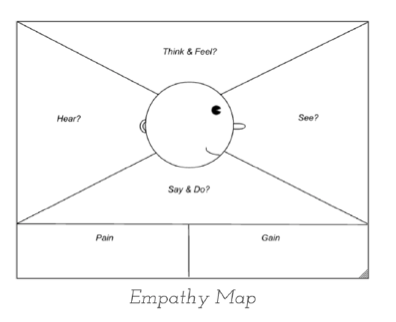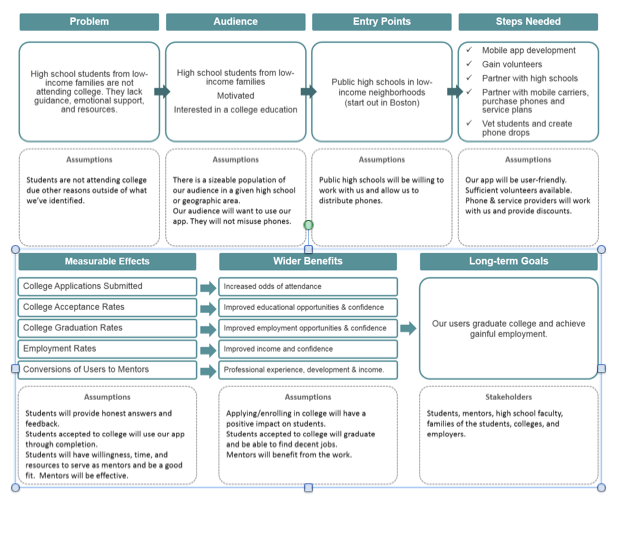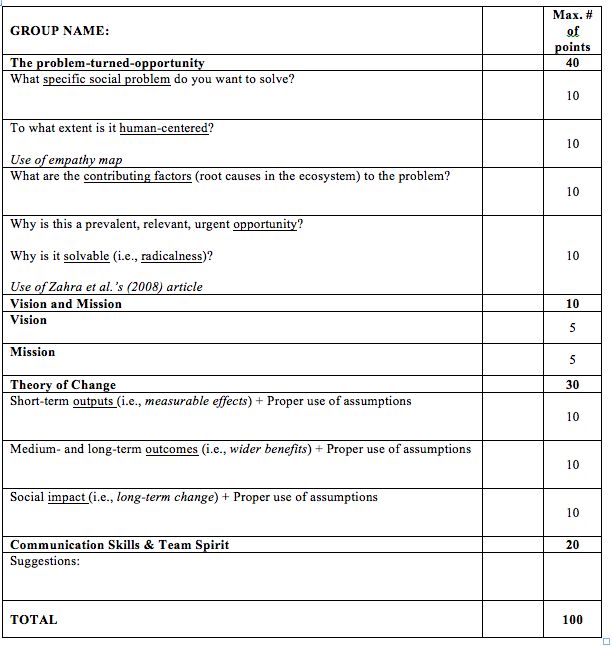Social Entrepreneurship Exercise: Developing your “Theory of Change”

The Theory of Change is a tool that is widely used among social entrepreneurship (SE) practitioners to map out the steps that will lead them to have the intended positive change on society. The Theory of Change helps identify the “preconditions, pathways, and interventions necessary for an initiative’s success” (Kickul & Lyons, 2016, p. 95), and can therefore be understood as a chain of causality: “if… then…”
I employ the “Theory of Change” framework as a road map during my SE elective course. For their term team project, I do not have my students—some of whom are freshmen—write a business plan as they may not have learned the tools yet, and it is not the focus of my course. Instead, I ask them to deploy, in teams, a plausible and sustainable solution to address a social problem of their choice (e.g., air quality, livelihoods, sanitation, homelessness, etc.)
Social and environmental problems exist worldwide. According to Kickul and Lyons (2016), social entrepreneurship ideas—that later turn into opportunities—can come from a variety of sources: personal experiences, hobbies or avocations, systematic or intentional search, serendipity or accidental discovery, awareness generated by the media. In addition, the list of the UN 17 Sustainable Development Goals, building on the previous 8 Millennium Development Goals, provides 17 areas where aspiring social entrepreneurs can learn more about specific social problems and measurable goals to be achieved by 2030.
Furthermore, I invite my students to update their Theory of Change throughout the semester as their understanding of the social problem and the context in which it takes place deepens, and their design of a solution to it evolves.
This exercise includes the following:
- A description of the “Theory of Change” tool
- A description of the key categories of the Theory of Change
- An explanation of how students can use it
- The “Empathy Map,” a tool to assess the extent to which the problem is human-centered
- An example of the Theory of Change framework completed, and a reading and accompanying documentary that illustrate the Theory of Change concept
- Additional resources for students to watch or to consult
- An explanation of how I use it in my SE course, and a grading rubric
What is Theory of Change?
Setting up a Theory of Change helps you define “whether your work is contributing towards achieving the impact you envision, and if there is another way that you need to consider as well."
The Theory of Change tool not only helps to clearly articulate and connect your work to your bigger goal, but also allows you to spot potential risks in your plan by sharing the underlying assumptions in each step.” (Development Impact & You, 2017)
Key Categories of the Theory of Change
The Theory of Change is made of several key categories (Kickul & Lyons, 2016, pp. 95-56):
1. The resources: Both tangible (funding, office space, equipment) and intangible (people, skills, knowledge, contacts, reputation) resources needed to accomplish the activities of the SE solution.
2. The activities: Operating activities that transform those resources into outputs.
3. The outputs of the SE activities: e.g., number of solar panels installed, number of ready-to-use therapeutic food pouches distributed, number of micro loans made to financially excluded women. But SE outputs can also be intangible, such as economic reinsertion of the long-term unemployed through SE, reduction in the number of homeless people in a city or neighborhood, etc.
4. The outcomes of the SE activities, distinguished between short (1 to 3 years) and long (4 to 6 years) term: What are the short- and long-term positive changes expected to take place as a consequence to the above-mentioned outputs? For instance, after regaining employment, what are the positive repercussions expected to happen for the formerly long-term unemployed individual? In the short term, it may simply be increased disposable income for the family. But a few years later, that economic empowerment may translate into better family health as higher disposable income may have been invested in healthcare for the family members.
5. The impact: In seven to 10 years after the SE activities, the individual may benefit from job security, lifelong employment, and overall increased quality of life for him/herself and his/her family members. At a higher level of analysis, regional or national for example, the impact of the SE may translate into decreased dependence on the government welfare system -- which, as a consequence, translates into decreased government expenditures for that issue.
How To Fill It Out
Below is an example of Theory of Change framework from the Development Impact & You website.

I find the Theory of Change framework from the Development Impact & You particularly valuable in that it breaks down the different categories outlined above into key questions that can guide students’ thought process. It also adds preliminary steps to be considered. Let’s review them.
1. What is the specific problem you are trying to solve?
Our world is plagued by an enormous amount of intractable social problems. Consistent with entrepreneurship literature and scholarship, I have my students read the article by Zahra and colleagues (2008), which helps them frame any social issues they can think of as opportunities rather than problems. In their article, Zahra and colleagues (2008) characterize SE opportunities as prevalent, relevant, urgent. They also discuss the degree to which the issue is accessible (i.e., solvable), and the degree of radicalness required to address it. I have my students evaluate the social-problem-turned-opportunity along these five dimensions before they start filling out the Theory of Change framework.
Additionally, I also invite my students to think about the possible contributing factors of the problem, to make sure that they address the root cause of the issue (if solvable, see above) and not the symptoms.
2. Who is your key audience?
In other words, around which humans (and their needs) is the problem centered? To answer that question, I invite my students to think of all the possible segments of users, who are similar in characteristics. These characteristics can include gender, industry sector, work activity, geographic location, profession, social identity, etc. Then, I ask them to prioritize the top three user groups who suffer the most from the specific social problem chosen in response to question #1. I also use the Empathy Mapping tool, detailed in section 4 below.
3. What is your entry point to reaching that audience?
Who, what organization, is going to help you reach that particular audience?
4. What steps are needed bring about change?
This question relates to the “Activities” category mentioned above.
5. What are the measurable effects of your work?
This question relates to the “Outputs” category which it expresses in terms of metrics.
6. What are the wider benefits of your work?
Think outcomes!
7. What is the long-term change you see as your goal?
The last part of the question is critical here. It stresses the fact that, after answering question #1, what is the problem, the second question to answer is question #7: what is the team’s long-term goal, i.e., impact, in terms of solving that problem?
Finally, and most importantly, it is critical that students think about and clearly outline the assumptions that they make as they respond to each of the seven above-mentioned questions.
Human-Centered Design & Empathy Mapping
To further refine answers to points 1) to 3) above, it is necessary that the students evaluate the extent to which the problem that they are addressing is human-centered.
The design aspect of the project affords students with an opportunity to potentially make a meaningful and sustainable impact on persons and communities in need by addressing a social or environmental problem that affects them. Therefore, the first step is for them to gain deep understanding of the social problem and the communities that it affects.
To start, I ask my students to talk to, or at least gather strong insights from, numerous stakeholders. In particular, and given the importance of empathy in SE (Mair & Noboa, 2006; Miller et al., 2012), I invite my students to describe every facet of the problem from the perspective of the people affected by it—or “users” of the designed solution. In other words, I invite and help my students to empathize with the target users. Empathy is composed of both a cognitive and an affective aspect. On the one hand, cognitive empathy, known as perspective-taking, refers to an individual’s disposition to understand others’ points of view. On the other hand, affective empathy, known as empathic concern, refers to someone’s ability to experience feelings of warmth and compassion for others (Davis, 1980).
To do so, I use the “Empathy Map” tool[1]:

Since the Theory of Change is based on a series of assumptions, the first assumptions to test are the students’ assumptions about the users’ reality and experience of the problem. This combines desk research and interviews with key stakeholders (if not the users themselves, because of long geographical distance or sensitive context; students usually contact stakeholders who have good knowledge of the context and users, such as NGOs). Students are then invited to ask and answer the following questions about the users’ daily experience of life:
- What do they hear?
- What do friends and family say? Who influences them and how? What communication channels are most reliable/useful?
- What do they think and feel?
- What is really important to them? What drives them? What worries them?
- What do they see?
- What does it look like around them? Who do they see? Who are their friends? What problems do they have?
- What do they say and do?
- What is their attitude? What do they say to others? What do they show in public?
To help my students adopt the perspective of the users, a good practice is to have them start by giving a contextually-adequate name to a user type. Then, students are invited to summarize the problem in a list of “pains” that are the most salient in the users’ daily life. Doing so, students develop lenses to frame the problem as an opportunity, which you can then tie to the Zahra et al. (2008) reading. Finally, students summarize the gains that the users could mostly benefit from. These “gains” form the first sketches of the solution that the team of students will later design.
Examples
Example of the Theory of Change Framework Completed:
“Social Enterprise” (name withheld for confidentiality purposes) believes that by providing a structured road map, peer mentorship, and free phones, we can improve college graduation rates and employment opportunities for children who come from low-income families.

Additional Illustrations of the Theory of Change:
This article provides more focus on why the Theory of Change matters and on the example of Harlem Children’s Zone (HZC), founded by Geoffrey Canada: https://ssir.org/articles/entry/zeroing_in_on_impact (Colby, Stone, & Carttar, 2004).
This article could be further enriched with excerpts of the movie: “Waiting for Superman” (2010), which features Geoffrey Canada and his organization. This one-hour, 50-minute documentary explores the state of the American education system.
Additional Resources
Great video example of a well-articulated Theory of Change, by Two Degrees Food:
More information on Human-Centered Design (HCD):
https://www.ideo.com/post/design-kit
How I Use It in My Social Entrepreneurship Course
Students are invited to update their Theory of Change throughout the semester as their understanding of the social problem and the context in which it takes place deepens, and their design of a solution to it evolves. Students give two formal presentations of their Theory of Change during the semester: one mid-term, and one at the end of the semester, embedded in their final term presentation. I use the following rubric for the presentation:

References
Colby, S., Stone, N. & Carttar, P. (2004). Zeroing in on impact. Stanford Social Innovation Review, Fall, 24-33.
Davis, M. H. (1980). A multidimensional approach to individual differences in empathy.
Kickul, J., & Lyons, T. S. (2016). Understanding social entrepreneurship: The relentless pursuit of mission in an ever changing world. Routledge.
Mair, J., & Noboa, E. (2006). Social entrepreneurship: How intentions to create a social venture are formed. In Social Entrepreneurship (pp. 121-135). Palgrave Macmillan UK.
Miller, T. L., Grimes, M. G., McMullen, J. S., & Vogus, T. J. (2012). Venturing for others with heart and head: How compassion encourages social entrepreneurship. Academy of Management Review, 37(4), 616-640.
Zahra, S. A., Rawhouser, H. N., Bhawe, N., Neubaum, D. O., & Hayton, J. C. (2008). Globalization of social entrepreneurship opportunities. Strategic Entrepreneurship Journal, 2(2), 117-131.
[1] I thank my colleague Dr. Sara Minard for bringing this very enlightening and powerful tool to my attention.
Additional Search Terms: entrepreneurship courses, teaching ideas, teaching resources, classroom ideas, entrepreneurship classes, business schools, business school classes, entrepreneurship students, professors






